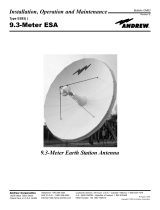
Bulletin 095007-000 • Revision F • July 2006 • Page 2 of 2
DB222 Broadband Antennas Andrew Corporation
(Continued from page 1)
INSTALLATION INSTRUCTIONS
.1. After removing the antenna from the shipping box, in-
spect it to be sure all parts are included and there is no
physical damage.
2. Inspect the antenna feed assembly output connector
to determine that it mates with the end of your station
transmission line. Do not remove any connector or cable
from the antenna feed assembly as they are all part of
your antenna.
3. Verify that the frequency to which the antenna has been
tuned is the frequency on which your radio system is to
operate.
4. Attach the furnished DB365-OS mounting clamps to
the bottom of the antenna mast at the designated loca-
tions.
5. Mount the antenna on the tower with the bottom dipole
above and facing away from the tower.
6. A check of the VSWR as measured at the antenna is
recommended at this point. Note this measurement for
future reference.
7. After checking the VSWR at the antenna, connect the
station transmission line to the antenna. Make con-
nections snug but do not apply heavy force with pliers.
Carefully wrap the connection with VAPOR-WRAP
®
(part
number 11317 or 11316.) Work the compound into all
cracks and smooth over outer jackets to avoid moisture
problems. Failure to waterproof the cable connection
may result in improper operation of your antenna.
8. To avoid physical damage to the cable, secure the feeder
cable and the antenna transmission line to the tower in
the best possible position
9. After the antenna and transmission line installation has
been completed, a careful visual check should be made
to ensure that:
• All mechanical connections are secure.
• The antenna is mounted on the proper leg of the tower
with sufcient physical clearance.
• All connections have been carefully wrapped with
VAPOR-WRAP to prevent moisture problems.
Table 1. Approximate Side Mounting Gains.
MECHANICAL DATA
Maximum Exposed Area............................................. 1.6 ft²
Wind Load (at 100 m.p.h.) ...........................................64 lbf
Bending Moment (at top clamp) ..........................290 ft. lbs.
Net Weight (with mounting clamps) ...........................12 lbs.
Shipping Weight ........................................................16 lbs.
VSWR (at 50 ohms)................................................... <1.5:1
Rated Power Input ..................................................... 500 W
Duraluminum Mast: 6061-T6 Aluminum 1-3/4” OD with
bottom wall thickness of 0.12 inches and top wall thickness
of 0.062 inches. Total length is 10 feet, 8 inches.
Mounting: Complete with clamps that will t round or angle
members up to 3-1/2 inches.
Standard Termination: Captive Type-N male attached to
end of exible lead.
SIDE MOUNTING
When antennas are side-mounted, their normal horizontal
patterns are distorted. Often this distortion can be used to
an advantage, but only if the pattern shape is known. Table
1 lists the approximate gains of the DB222 and DB222E
antennas when they are side-mounted on triangular towers
that measure 18 to 24 inches between legs.
The DB5001 side mount kit is required for side mounting.
Note that the side mount arm should extend from the tower
at zero degrees azimuth.
Antenna
Azimuth
0° 90° 180° 270°
DB222 4.0 dB 5.5 dB –3.0 dB 5.5 dB
DB222E
Elements facing
away from tower
6.3 dB 4.5 dB –7.0 dB 4.5 dB
DB222E
Elements facing
toward tower
3.0 dB 5.0 dB –1.0 dB 5.0 dB
Andrew Corporation
Base Station Antennas
Printed in U.S.A.
Copyright © 2006 by Andrew Corporation


















